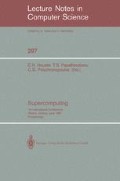Abstract
Concurrent requests to a shared variable by many processors on a shared memory machine can create contention that will be serious enough to stall large machines. This idea has been formalized in the “hot spot” traffic [PfNo85], where a fixed fraction of memory requests is for a single shared variable. “Combining”, in which several requests for the same variable can be combined into a single request, has been suggested as an effective method of alleviating the contention. Lee, Kruskal, and Kuck [LeKK86] introduced the idea of “k-way combining”, which shows that the effectiveness of combining depends on k, the maximum possible number of requests combined into a single request at a switch. This paper introduces a scheme to remedy k-way combining in order to avoid the contention without incurring impractically large storages in switches of multistage interconnection networks.
Preview
Unable to display preview. Download preview PDF.
References
S. Dickey, R. Kenner, and M. Snir, “An Implementation of a Combining Network for the NYU Ultracomputer” Ultracomputer Note #93, NYU, Jan. 1986.
S. Dickey, R. Kenner, M. Snir, and J. Solworth, “A VLSI Combining Network for the NYU Ultracomputer” IEEE Proc. of the Intl. Conf. on Computer Design, pp. 110–113, Oct. 1986.
J. Edler, A. Gottlieb, C. P. Kruskal, K. P. McAuliffe, L. Rudolph, M. Snir, P. J. Teller, and J. Willson “Issues Related to MIMD Shared-Memory Computers: The NYU Ultracomputer Approach”, The 12th Annual International Symp. on Computer Architecture, June, 1985, pp.126–135
T. Y. Feng, “A Survey of Interconnection Networks”, IEEE Computer, Vol.14 no.12 1981, pp. 12–27
D. D. Gajski, D. J. Kuck, D. Lawrie, and A. Sameh, “Cedar — A Large Scale Multiprocessors”, Proc. of the 1983 International Conf. on Parallel Processing, Aug. 1983, pp. 524–529
G. R. Goke and G. J. Lipovski, “Banyan Networks for Partitioning Multiprocessor Systems”, The 1st Annual Symposium on Computer Architecture, 1973, pp. 21–28
A. Gottlieb, R. Grishman, C. P. Kruskal, K. M. McAuliffe, L. Rudolph, and M. Snir, “The NYU Ultracomputer — designing an MIMD shared memory parallel computer”, IEEE Trans. on Computers, Vol. C-32, No. 2, 1983
C. P. Kruskal, L. Rudolph, and M. Snir, “Efficient Synchronization on Multiprocessors with Shared Memory”, The 5th ACM SIGACT-SIGOPS Symp. on Principles of Distributed Computing, Aug. 1986
C. P. Kruskal and M. Snir, “Some Results on Multistage Interconnection Networks for Multiprocessors”, NYU Ultracomputer note 41; also in Proc. 1982 Conf. Informat. Sci. Syst., Princeton Univ., Princeton, NJ, Mar. 1982
C. P. Kruskal and M. Snir, “The Performance of Multistage Interconnection Networks for Multiprocessors”, IEEE Trans. on Computers, Vol. c-32, No. 12, Dec. 1983, pp.1091–1098
C. P. Kruskal, M. Snir, and A. Weiss, “The Distribution of Waiting Times in Clocked Multistage Interconnection Networks”, Proc. of the 1986 International Conf. on Parallel Processing, Aug. 1986, pp. 12–19
D. J. Kuck, E. S. Davidson, D. H. Lawrie, and A. H. Sameh, “Parallel Supercomputing Today and the Cedar Approach”, Science, Vol. 281, Feb. 28, 1986, pp. 967–974
D. H. Lawrie, “Access and Alignment of Data in an Array Processor”, IEEE Trans. on Computers, Vol. c-24, no.12 1975, pp.1145–1155
G. Lee, C. P. Kruskal, and D. J. Kuck, “The Effectiveness of Combining in Shared Memory Parallel Computers in the Presence of ‘Hot Spots'”, Proc. of the 1986 International Conf. on Parallel Processing, Aug. 1986, pp.35–41
G. Lee, “A Performance Bound of Multistage Combining Networks”, submitted for publication in IEEE Trans. on Computers, 1987
G. Lee, “A Balanced k-way Combining Switch”, in preparation, 1987
R. Lee, “On Hot Spot Contention”, ACM Computer Architecture News, Vol.13 no.5 1985, pp.15–20
J. A. Patel, “Performance of Processor-Memory Interconnections for Multiprocessors”, IEEE Trans. on Computers, Vol. c-30, 1981, pp. 771–780
G. F. Pfister, W. C. Brantley, D. A. George, S. L. Harvey, W. J. Kleinfelder, K. P. McAuliffe, E. A. Melton, V. A. Norton, J. Weiss, “The IBM Research Parallel Processor Prototype (RP3): Introduction and Architecture”, Proc. of the 1985 International Conf. on Parallel Processing, Aug. 1985, pp.764–771
G. F. Pfister and V. A. Norton, “'Hot Spot’ Contention and Combining in Multistage Interconnection Networks”, IEEE Trans. on Computers, Vol. c-34, No.10, 1985, pp.943–948
Howard Jay Siegel, Interconnection Networks for Large-Scale Parallel Processing, Theory and Case Studies, Lexington Books. 1985
H. Sullivan, T. Bashkow, and D. Klappholtz, “A Large Scale Homogeneous Fully Distributed Parallel Machine”, Proc. of the Fourth Symp. on Computer Architecture, 1977, pp. 105–124
M. C. Wong, “A Combining Omega Network: Performance vs Implementation” IBM Research Report, RC 11977 (#53952), June 1986.
P. C. Yew, N. F. Tzeng, and D. H. Lawrie, “Distributing Hot-Spot Addressing in Large Scale Multiprocessor”, Proc. of the 1986 International Conf. on Parallel Processing, Aug. 1986, pp.51–58
C. Q. Zhu and P. C. Yew, “A Synchronization Scheme and Its Applications for Larger Multiprocessor Systems”, Proc. 4th International Conf. Distributed Computing Systems, May 1984, pp. 486–493
Author information
Authors and Affiliations
Editor information
Rights and permissions
Copyright information
© 1988 Springer-Verlag Berlin Heidelberg
About this paper
Cite this paper
Lee, G. (1988). Another combining scheme to reduce hot spot contention in large scale shared memory parallel computers. In: Houstis, E.N., Papatheodorou, T.S., Polychronopoulos, C.D. (eds) Supercomputing. ICS 1987. Lecture Notes in Computer Science, vol 297. Springer, Berlin, Heidelberg. https://doi.org/10.1007/3-540-18991-2_5
Download citation
DOI: https://doi.org/10.1007/3-540-18991-2_5
Published:
Publisher Name: Springer, Berlin, Heidelberg
Print ISBN: 978-3-540-18991-6
Online ISBN: 978-3-540-38888-3
eBook Packages: Springer Book Archive

